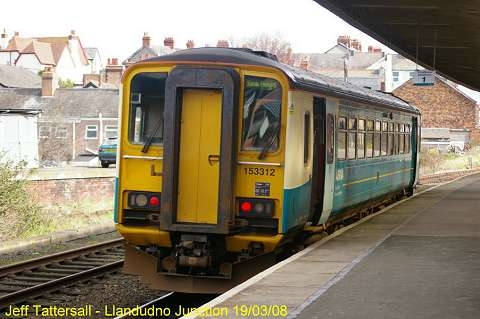Normal
153 303
153 312
153 318
153 323
153 327
153 353
153 362
153 382
Active travel with
cycle racks
153507 (vehicle 52307)
153528 (vehicle 52328)
153531 (vehicle 52331)
153552 (vehicle 52352)
153568 (vehicle 52368)
153572 (vehicle 52372)

Technical Specification:
Each car has one Cummins NT855R5 diesel engine of 213 kW (285 HP) driving both axles of the bogie at the end with the new cab, through a Voith hydraulic transmission and Gmeinder final drives, identical to the drive equipment of Class 150 and 156. Maximum speed is 75 mph. Air suspension units are provided for each bogie, the three-step air-operated brakes have a variable load feature, and public address equipment is fitted. Length of each car is 23.71 metres.
Class 153 have BSI (Bergische Stahl Industrie) couplers, and can work in multiple with Classes 142, 150, 156 and 158.
Transport for Wales (TfW) has 13 these single cars. No
longer common in North Wales, they can be found on the
'Heart of Wales' line (Shrewsbury - Llandrindod -
Llanelli) and the stopping trains between Crewe and
Shrewsbury. Six of them have been modified for 'Active
Travel' by removing some seats and replace them with cycle
racks; they have been given a colourful vinyl livery, and
will run paired with a 'normal' 153.
Historical notes
Class 153 came about when Regional Railways resolved in the early 1990s to split their BREL / Leyland National Bus-built two-car Class 155 units into two independent single cars. Hunslet Barclay of Kilmarnock were charged with rebuilding the inner ends with new cabs and adding a toilet to the 52xxx vehicles which did not originally have one. All the 155s were converted, except for seven two-car units which were bought new by West Yorkshire Passenger Transport Executive and still work for Northern Rail in that area in original two-car form.
In the privatisation area they have been shared between various companies with requirement to operate rural services, with some shuffling and swapping of fleets having taken place.
They are controversial and unloved vehicles, especially with train crews who complain about the extra cab created during the rebuild, which is smaller that the original design at the other end, and uncomfortable, as well as often being too hot. Cyclists and pushchair-owners also find the entrance vestibule behind the new cab hard to negotiate. Their construction, based on body units originally designed for the Leyland National bus, sitting on an underframe built by BREL leaves something to be desired, too - a slight sag towards the centre of the body can often be detected. Unlike most of the other late-BR railcars, they have gained a variety of unofficial nicknames, usually derogatory: 'tin rockets' and 'dogboxes' are two that can often be heard.
Compiled by Charlie Hulme.